
Pitcher plants are carnivorous plants known as pitfall traps—a prey-trapping mechanism featuring a deep cavity filled with digestive liquid. The traps of pitcher plant are considered to be "true" pitcher plants and are formed by specialized leaves. The plants attract and drown the prey with nectar.
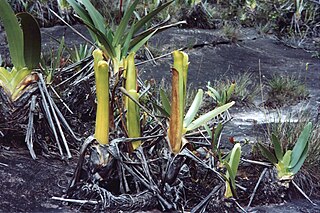
Brocchinia reducta is a carnivorous plant in the bromeliad family. It is native to southern Venezuela, Brazil, Colombia, and Guyana, and is found in areas with nutrient-poor, high moisture soil. B. reducta is able to grow in sparse conditions, which is evident when it uses its roots as anchors over rocks. Its funnel-like structure and waxy coating, among other characteristics, suggest that this plant is carnivorous.
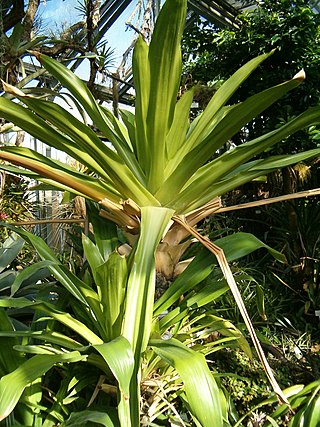
Brocchinia is a genus of the botanical family Bromeliaceae, and is the sole genus of the subfamily Brocchinioideae, containing 20 species. The genus is named for Giovanni Battista Brocchi, Italian naturalist (1772–1826). Brocchinia species are native primarily to the ancient Guayana Shield in southern Venezuela and Guyana, with some species extending into Colombia and northern Brazil. Its species are generally restricted to areas of sand and sandstone of the Roraima Formation; a few occur on granite.

Balmaceda is a genus of jumping spiders that was first described by George Peckham & Elizabeth Peckham in 1894.
Pithecellobium pithecolobioides, known as the granadillo de río, is a tree species in the legume family (Fabaceae).
Thermomesochra reducta is a species of copepod in the family Canthocamptidae, and the only species in the genus Thermomesochra. It is listed as Data Deficient on the IUCN Red List.

Macrozamia reducta is a species of plant in the family Zamiaceae. It is endemic to New South Wales, Australia.

Limenitis reducta, the southern white admiral, is a butterfly of the family Nymphalidae.
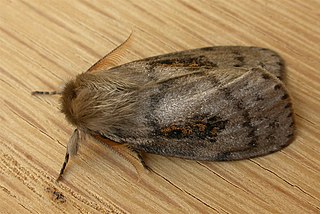
Leptocneria reducta, the white cedar moth, is a moth of the subfamily Lymantriinae. The species was first described by Francis Walker in 1855. It is found in all of Australia, except Tasmania.

Tillandsia fendleri is a species of flowering plant in the family Bromeliaceae. It is epiphytic. This species is native to the West Indies and South America.

Agathia lycaenaria is a species of moth of the family Geometridae first described by Vincenz Kollar in 1848. It is found from India to Australia.
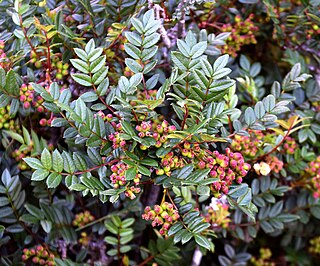
Sorbus reducta, the dwarf Chinese mountain ash, is a species of flowering plant in the family Rosaceae, native to western China. Growing to 1.5 m (5 ft) tall by 2 m (7 ft) wide, it is a dense deciduous spreading shrub. Each leaf, 10 cm (4 in) long, has up to 15 leaflets which turn to brilliant shades of red in the autumn (fall). White flowers in spring are followed by red or pink, and then white berries in autumn.
Icteralaria reducta is a species of moth of the family Tortricidae. It is found in Costa Rica.

Helophora is a genus of dwarf spiders that was first described by Anton Menge in 1866.
Pygospina is a genus of delphacid planthoppers in the family Delphacidae. There are about five described species in Pygospina.
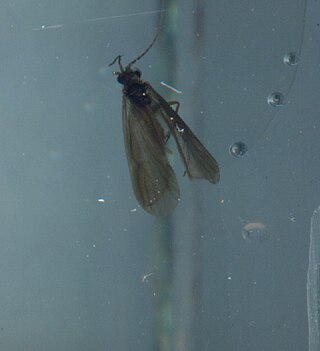
Lype is a genus of net tube caddisflies in the family Psychomyiidae. There are more than 20 described species in Lype.
Helophora reducta is a species of sheetweb spider in the family Linyphiidae. It is found in the United States.

Autochton potrillo, the potrillo skipper, is a species of dicot skipper in the butterfly family Hesperiidae. It is found in the Caribbean Sea, Central America, North America, and South America.
Locustopsidae is an extinct family of grasshoppers in the order Orthoptera. There are about 17 genera and more than 60 described species in Locustopsidae.
Locustopsis is an extinct genus of grasshopper in the family Locustopsidae.












